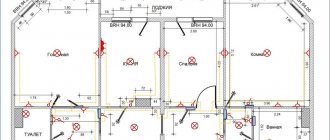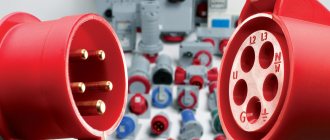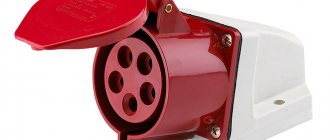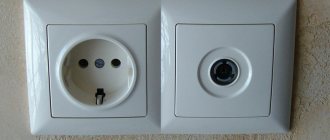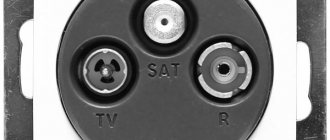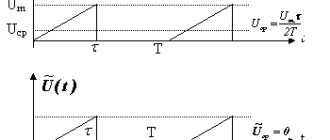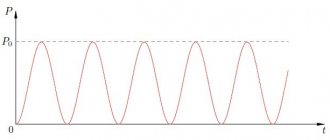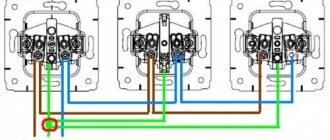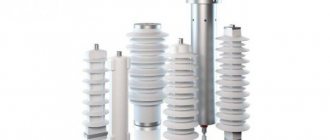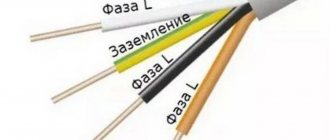According to the “Rules for the technical operation of consumer electrical installations” clause 11.6. Paragraph 2: All plug sockets must have inscriptions indicating the rated voltage and a symbol indicating the type of voltage. According to this document, all sockets in enterprises, organizations, hotels and public and other places must be marked indicating the rated voltage and type of current (DC, AC). Stickers for sockets «
220V" are made from polyester with a matte surface. Socket sticker size "
220V" (HxW) 11x35mm is selected taking into account gluing to the socket frame of most manufacturers. Labels are provided on sheets of cut sheets with a sticker thickness of 200 microns, allowing them to be easily removed from the sheet. There are 50 stickers per sheet, ready for use.
Power sockets with a capacity of 380V are actively used in industry and construction. The design can withstand both mechanical and electrical loads. Convenient fastenings prevent short circuits and equipment failure. Unique features, simple connection and safe operation are the main advantages of this product. The main thing is to correctly connect the 380-volt power outlet.
Electrical installation devices
6.6.21.
The requirements given in paragraphs. 6.6.22-6.6.31, apply to devices (switches, switches and sockets) for rated current up to 16 A and voltage up to 250 V, as well as plug connections with protective contact for rated current up to 63 A and voltage up to 380 V ¶ 6.6.22. Devices installed hidden must be enclosed in boxes, special casings, or placed in holes in reinforced concrete panels formed during the manufacture of panels at construction industry factories. The use of flammable materials for the manufacture of covers covering openings in panels is not allowed. ¶
6.6.23. Socket outlets installed in locked storage areas containing flammable materials or materials in flammable packaging must have a degree of protection in accordance with the requirements of Chapter. 7.4. ¶
6.6.24. Plug sockets for portable electrical receivers with parts subject to protective grounding must be equipped with a protective contact for connecting a PE conductor. In this case, the design of the socket must exclude the possibility of using current-carrying contacts as contacts intended for protective grounding. ¶
The connection between the grounding contacts of the plug and the socket must be established before the current-carrying contacts come into contact; the shutdown order should be reversed. The grounding contacts of socket outlets and plugs must be electrically connected to their housings if they are made of conductive materials. ¶
6.6.25. Plug connectors must be designed in such a way that they cannot be plugged into socket outlets with a higher rated voltage than the rated voltage of the plug. The design of sockets and plugs should not allow the inclusion of only one pole of a two-pole plug, as well as one or two poles of a three-pole plug, into the socket. ¶
6.6.26. The design of plug connectors must prevent tension or breakage of the wires connected to them at the connection points. ¶
6.6.27. Switches and switches for portable electrical receivers should, as a rule, be installed on the electrical receivers themselves or in electrical wiring laid fixedly. On moving wires it is allowed to install only switches of a special design intended for this purpose. ¶
6.6.28. In three- or two-wire single-phase lines of networks with a grounded neutral, single-pole switches can be used, which must be installed in the phase wire circuit, or two-pole ones, and the possibility of disconnecting one neutral working conductor without disconnecting the phase conductor must be excluded. ¶
6.6.29. In three- or two-wire group lines of networks with an insulated neutral or without an insulated neutral at voltages above 50 V, as well as in three- or two-wire two-phase group lines in a 220/127 V network with a grounded neutral in rooms with increased danger and especially dangerous ones, they should be installed double pole switches. ¶
6.6.30. Socket outlets must be installed: ¶
1. In industrial premises, as a rule, at a height of 0.8-1 m; when supplying wires from above, installation at a height of up to 1.5 m is allowed. ¶
2. In administrative, office, laboratory, residential and other premises at a height convenient for connecting electrical appliances to them, depending on the purpose of the premises and interior design, but not higher than 1 m. It is allowed to install plug sockets in (on) specially adapted for this skirting boards made of non-combustible materials. ¶
3. In schools and child care institutions (in premises for children) at a height of 1.8 m. ¶
6.6.31. Switches for general lighting fixtures should be installed at a height of 0.8 to 1.7 m from the floor, and in schools, nurseries and kindergartens in rooms for children - at a height of 1.8 m from the floor. It is possible to install switches under the ceiling with cord control. ¶
Source: www.elec.ru
Color marking of wires in three-phase networks: what color indicates phase and zero
- Concept of color coding of wires and cables
- Electrical safety
- What does GOST and PUE say about color marking of wire products?
- Colors in electrical wiring
- Phase
- Neutral
- Grounding
- Colors for 220 V and 380 V networks
- Checking that the wires are connected correctly
- How to find out what color a phase is
- How is the verification carried out?
- Using a tester
- Using a multimeter
- Wire insulation colors plus and minus
- How to distinguish wires by insulation color in multi-core cables
- Letter designation of wires
- Additional markings
- Custom wires and color coding
- Designation of wire colors on electrical diagrams
- Color coding abroad
- What to do if there is no color coding
- Recommendations from experts
Separating electrical wires by color makes it easier for electricians to perform various tasks. For this purpose, a special marking was developed, regulated by PUE (rules for installing electrical installations) and GOST.
Concept of color coding of wires and cables
The color marking of wires serves as an accurate determinant of its group (zero, phase, ground) and scope of application. For aggressive environments or with intense cooling, the color is applied to the entire wire. Painting is allowed only at switching points.
Thanks to this marking system, both installation and repair work have been simplified. The percentage of personnel errors has decreased due to the ability to visually determine the type of wire.
Electrical safety
The human eye does not see the electric field, and therefore is not able to detect live wires. Touching them is extremely dangerous and can be fatal. To protect people and reduce risks to the system, standards were adopted (GOST R 50462-92).
Oil-impregnated paper and plastic insulation are the most common in Russia. The first is used in an aggressive environment because of its ability to regenerate, that is, restore its previous properties. Today, PVC insulation is gaining great popularity.
What does GOST and PUE say about color marking of wire products?
GOST specifies several colors. Only the use of green in combination with yellow and blue is strictly regulated. The color of the phase can be any of those listed in the rules for installing electrical devices. Neutral and grounding are clearly regulated. Each color has its own letter designation in Latin and Cyrillic.
220 volt designation on sockets
According to the “Rules for the technical operation of consumer electrical installations” clause 11.6. Paragraph 2: All plug sockets must have inscriptions indicating the rated voltage and a symbol indicating the type of voltage. According to this document, all sockets in enterprises, organizations, hotels and public and other places must be marked indicating the rated voltage and type of current (DC, AC). Stickers for sockets «
220V" are made from polyester with a matte surface. Socket sticker size "
220V" (HxW) 11x35mm is selected taking into account gluing to the socket frame of most manufacturers. Labels are provided on sheets of cut sheets with a sticker thickness of 200 microns, allowing them to be easily removed from the sheet. There are 50 stickers per sheet, ready for use.
Power sockets with a capacity of 380V are actively used in industry and construction. The design can withstand both mechanical and electrical loads. Convenient fastenings prevent short circuits and equipment failure. Unique features, simple connection and safe operation are the main advantages of this product. The main thing is to correctly connect the 380-volt power outlet.
Features of the 380V outlet
Power cable connectors are designed for heavy-duty applications. The industrial plug and heavy-duty 380V socket are protected by a durable housing that can withstand minor impacts. Simplicity of connection, strong plastic and high throughput allow the connection structure to be used outdoors, in industrial workshops or during construction work. The product is subject to increased safety requirements.
The contacts have a large contact area, which reduces the load and eliminates possible overheating. Each cable clamp is secured with a screw connection that holds the wire in its seat. The copper construction is protected from corrosion and is also resistant to oxide film growth.
The clamp holds the cable securely, preventing breakage. Special grooves ensure a strong connection and eliminate backlash. The contacts have different diameters and are located at their own angles. The connection provides protection against unbalanced connection, which prevents short circuits.
With high voltage, the risk of arcing increases. Each 380 socket has mechanical or automatic protection. The device can stop power supply until removed. The solution reduces the risk of equipment failure or skin burns.
The plastic is resistant to overheating, non-flammable and can withstand direct sunlight. Protection from dust and moisture is provided, which will preserve the quality of parts and make work safe.
The 380 volt electrical outlet is manufactured in accordance with the IP 44 or IP67 standard.
Types of sockets
Power connections differ in shape, method of fastening and number of contacts. The socket can have from 3 to 5 connections. To understand the difference, it is important to study the operating principle. In the CIS countries, a three-phase network with a voltage of 380V is used. A standard apartment uses 220V. This indicator can be obtained by connecting one of the three phases to the neutral wire. To connect a 380-volt industrial outlet, it is enough to combine two phases and a neutral wire. A conventional electric stove has a similar connection principle.
There are several standards for power connectors:
- 2P+PE - two phases and one grounded contact are used;
- 3P+PE - 3 power cables and one grounded;
- 3P+PE+N - 3 phases, one ground and zero;
- 3P+N - three power contacts and one neutral.
Switching connections differ not only in the number of contacts, but also in the structure of the housing. There are cable structures that serve to connect portable devices. Flange switches are manufactured with a mount that can be built into the wall directly or at an angle. The last type is overhead sockets. Some cases are equipped with an additional protective cap.
Areas of use
The main areas of application for three-phase connectors remain industrial and construction sites. Almost all welding machines, mixers, industrial hammer drills, pumps and pumps used in large facilities have an operating voltage of 380 volts.
One 3-phase socket, if we are talking about the power version, is capable of providing up to 63 amperes of load. And of course it cannot be compared with a regular 220 volt network. And if it is necessary to warm up a concrete screed, 380 volts has no alternative.
However, in everyday life this tension is applied no less, especially when it comes to a private home. The motor on the entrance gate, pump, boiler, electric stove - all of them can be designed for a 380 volt network. That is why they are trying to extend a three-phase network to every home. How to install an introductory board, read the article on our website. Whether to use a 380 volt network or not depends on each specific case. But there must be one. And if there is a three-phase network, there must be connectors for it.
Sources
- https://StrojDvor.ru/elektrosnabzhenie/kak-podklyuchit-rozetku-na-380-volt-vidy-rozetok-i-osobennosti-montazha/
- https://electromc.ru/rozetka-shtepselnaya-s-zazemlyayushhim-kontaktom/
- https://FB.ru/article/367047/rozetka-volt-vidyi-harakteristiki-shema-i-podklyuchenie
- https://MasterServisNsk.ru/elektronika/kak-podklyuchit-rozetku-na-380.html
- https://istra-gaz.ru/raschety/rozetka-380-volt-podklyuchenie-markirovka-konstruktsiya.html
- https://electry.ru/rozetki/trehfaznaya-rozetka.html
Connection methods
High voltage is dangerous to life, so safety precautions and connection rules should not be neglected.
The basis of any connection is the cable. It is important to choose the correct section that is suitable in size and can withstand the potential load. According to GOST, for a socket with a voltage of 380V and a current of 16 A, a wire with a cross-section of 1.5 to 4 mm is sufficient. The plug cable must be a minimum of 1.5 and no more than 2.5 mm. The thickness of the grounding wire should be 6 mm.
When installing switching elements, it is important to use the rule: supply cable - socket, receiving cable - plug. When stripping the wire, do not allow the wire to break off or become tangled. The more uniform the contact part of the cable is, the better the transmission and the less overheating.
Four-wire networks
Installation of wires begins with disassembling the housing. A 380 volt switch socket has 4 contacts, three of which are phase. Near the contacts you need to find the designations L1 L2 L3 and connect three phase wires to them in random order. Next, you need to find the neutral wire and clamp it to the terminal marked with the letter N.
Five-wire networks
When connecting a connector with five contacts, a scheme similar to the previous one is used. The designation near the contact pads is the same: L1 L2 L3 - phase, N - zero and PE - ground wire. The presence of earth requires an additional circuit element - an RCD. This connection will prevent electric shock if the housing or mounting rail is energized.
Connecting a three-phase socket
The connection can occur either with or without the use of an RCD. It all depends on the presence of a protective grounding cable. The connection is symmetrical, so the order of connecting the power cables is arbitrary. At the end of installation work, you should check the correct connection and correct errors.
Advice from experienced electricians
Classification of degrees of protection
Three-phase sockets must be carefully selected and installed. It is necessary to be guided by several basic points. The first is current strength. There are three types - 16, 32 and 64 A, respectively. The required one is selected based on the planned load.
The protection class shows the degree of resistance of the outlet to humidity, dust, and dirt. IP mark and numbers - the higher the value, the better, especially if there is moisture in the premises: bathrooms, bathhouses, etc.
An additional point is the installation method. The socket can be mounted on the wall (overhead) or a separate socket can be made (hidden). However, the type of device differs significantly.
The number of connecting contacts - four, five, seven - depends on the wiring diagram used and the required level of network reliability
Particular attention is paid to the method of fastening - screwless ones may turn out to be of poor quality, disposable
You can install and connect a three-phase reinforced socket yourself if you familiarize yourself with the basic requirements and follow safety rules when working with electricity. To make it easier to replace the power point, it is better to choose a classic model, otherwise you will have to change each one in the room or purchase additional ones in advance. The design and location of incoming groups are individual and do not affect performance.
Checking sockets
Before operation, it is important to do a check, which consists of four main points:
- Visual inspection for possible physical defects in the housing.
- If you have a megohmmeter, the strength of the insulating coating is checked. During diagnostics, the 380 volt outlet must be de-energized.
- A short circuit is created using the device to check the correct connection.
- Measurement of linear and phase voltage at idle.
During testing, the operating voltage between phases should be no more than 380V and 220V on one core. At the end, you should once again check the correctness and quality of the connection. A poorly tightened contact will overheat and fail, damaging the housing.
If the circuit opens, an arc may occur, creating a danger to life and risk of failure. To avoid this phenomenon, always turn off the power supply before dismantling. More expensive versions have an automatic transmission.
During operation, the wires heat up and expand. As a result, the screw connections become loose, resulting in poor contact. All wires must be re-tightened every year.
The product description is for informational purposes only and may differ from the description presented in the manufacturer’s technical documentation. Recommend when buying check the desired functions and features. You can report an inaccuracy in the product description - select it and press Shift+Space
Self-adhesive sticker S10 “220V” is used to warn of electrical hazardous areas (used in conjunction with other fire safety signs).
Dimensions: 100x50 mm.
The plate complies with the requirements of GOST R 12.4.026-2001.
Source: morflot.su
Legend
Special symbols are used to mark the switch position:
Electrical measuring instruments such as multimeters are good because they can be used to determine not only voltage, but also other current characteristics. They are also used to “ring” circuits, to test semiconductor devices, and to determine the capacitance of a capacitor.
To measure a particular parameter, you just need to switch the multimeter to the appropriate mode, and then apply the probes to the desired section of the circuit. On analog instruments, as a rule, there are three scales, each of which corresponds to a specific parameter. Electronic devices simply display the measurement result on the screen, making them easier to work with.
Measuring voltage with a multimeter is not at all difficult, because the device itself is very easy to use. But if any problems still arise, you should look at the instructions for use, where the measurement process is described in detail.
How to correctly designate sockets and switches on diagrams
Any proper repair or construction begins with a drawing, and sometimes absolutely everything depends on how well it is drawn up. After all, the drawing not only indicates where and how the supply wires will be laid, but also indicates distribution boxes, sockets and switches, and each of these elements has its own symbol. In this article I will tell you how sockets and switches are designated for open, hidden placement and much more.
Regulations
To ensure that in each specific case the power engineer does not come up with a “bicycle” and that absolutely any power engineer can read the drawn up diagram, standards were introduced; this material is based on GOST 21.210-2014
. Elementary geometric figures are taken as the basis; by combining them, one can obtain a symbol for a particular element.
How sockets are depicted
We will begin our review with the simplest sockets for external installation: so, their symbol is as follows:
These were sockets without grounding, but with flush-mounted grounding contacts, they are drawn as follows:
If you look at the diagrams where the sockets in the bathroom are indicated, you can see that the inside of them is painted over. This means that these sockets have increased moisture protection IP 44 or even IP 55.
Computer sockets are designated as follows:
The only nuance is the fact that according to GOST it is not clear how to designate a waterproof socket for indoor installation.
It seems that everything is more or less clear with sockets, let's now find out how the switches are designated.
Symbol of switches
The image of the switches is also standardized and represents a circle with a dash in the upper half and a hook at the end:
Flush installation switches are shown as follows
All the above switches are classified as switching devices with protection IP 20-23. The designation of waterproof switches differs from ordinary ones only in that the protected ones have a painted circle.
Pass-through switches are designated as follows:
Often, to save space and money, so-called combined units are chosen, which include, for example, a socket and a switch. Such hybrids have their own image, let's look at them in more detail.
This is how sockets and switches are designated in accordance with the current GOST. This information will allow you to read correctly and also draw up a wiring diagram in your house or apartment.
Source: zen.yandex.ru
What types of electrical safety posters and signs are there?
You are here: When repairing, adjusting or installing electrical installations, it is very important to use special posters and electrical safety signs.
They are designed to prohibit actions related to turning on or off devices, which in turn are used to supply/disconnect voltage.
In simple words, various kinds of signs notify personnel that work is taking place in a certain area, so touching buttons, switches and machines is strictly prohibited.
In addition, posters and safety signs used in electrical installations can be used to inform that a person is approaching a live object, or to indicate the workplace.
In this article we will look at what types of posters and signs in electrical engineering there are, where they are used and what requirements apply to the places where they are installed.
Prohibiting
So, prohibitory signs and posters in electrical installations include the following:
- "Dangerous! Electric field! Passage is prohibited without protective equipment.” This poster warns that in the nearby area a possible dangerous effect of an electric field cannot be ruled out, therefore it is prohibited to go in a further direction without electrical protective equipment. Installation location - outdoor switchgear with a voltage of 330,000 Volts and higher. According to safety rules, it is installed at a height of 1.8 meters on the very fence of the zone, the electric field strength of which exceeds 15,000 Volts per meter.
- "Do not turn on. People are working." Installed on keys and buttons that control switching devices in order to prevent power supply. If there are no switching devices in the circuit and the voltage is up to 1 kV, the poster should be hung near the removed fuses. Scope of application: electrical installations up to 1000 Volts and above.
- "Do not turn on. They work on the line." Purpose and installation location are the same as the previous poster. Scope of application: overhead and cable lines where work is carried out.
- “Working under tension. Do not turn it on again." . Scope of application: keys that control overhead line switches. This prohibitory poster must be posted to ensure that no one manually turns on the power during repair work on the overhead line.”
This entire list of posters is prohibitive and is used in the electric power industry. Please note that the products can be portable or stationary (installed once).
An important requirement is that safety signs and posters must be made from electrical insulating materials.
Metal plates may only be used if they are permanent and located at a sufficient distance according to the requirements from elements that may be energized.
Warning
Warning signs and posters are used to inform a person about approaching an area that is energized. This type of safety signs includes:
- “Don’t get in! He will kill." Warns a person that when lifting, it is possible to approach elements that are under dangerous voltage.
- "Trial! Danger to life." Such a poster must be hung at the workplace when testing high-voltage equipment. The installation location is the fencing of this very workplace. The caption warns that there is a possibility of electric shock.
- “Stop! Voltage". Surely each of you has seen this poster on electrical installations and understands what it warns about.
- "Carefully! Electrical voltage." The safety sign is made in the form of a triangle with equal sides. It is used for installation on the doors of substations, power plants and electrical installations, as shown in the photo below.
Classification according to consumer power
The division into types is carried out based on the total power of electrical devices that can be connected to them, that is, consumers.
The ideal option is a separate outlet for each device. But more often there is a need to connect several at once. A portable socket (otherwise called an extension cord, doubler, double) will help you do this.
The formula will help you find out how much power an outlet should have for each individual piece of household appliance: divide the power of the device by the voltage. To the resulting value you need to add a few Amps for “reserve”.
Soviet designs had a power of 6 and 10A, modern ones are designed for 16A.
There are products designed for high power - 25A, 32A. They are used extremely rarely in domestic conditions. The connection occurs in a permanent way using a cable, which is why they are called cable sockets.
Many types of these devices operate with a current of 220 Volts and 50 Hertz. However, these figures vary depending on the country. For example, they may be different for Kenya, Turkey, Greece, Dominican Republic, Russia, Tunisia.
What is the standard voltage in the network according to GOST in the Russian Federation: 220 or 230 Volts?
Everyone is accustomed to the designation above 220V sockets and almost no one is tormented by doubts about the veracity of the indicated rating. However, among experts there are often disagreements about the relevance of the supply voltage. Therefore, next we will consider which network voltage standard according to GOST in the Russian Federation: 220 or 230 V is correct.
The evolution of network voltage - where it all began
The level of standard voltages has constantly changed over the past 100 years for domestic household networks, depending on the degree of technological development. Thus, at the dawn of the electrification of the countries of the Soviet camp, a nominal value of 127 V was set for consumers of electrical energy. This system of nominal parameters came into use thanks to the developments of Dolivo-Dobrovolsky, who proposed three-phase generation instead of the outdated two-phase. It should be noted that back in the late 30s of the last century, the voltage standard of 127 V already poorly corresponded to the increased production needs, it was then that the first attempts to replace it arose, but with the outbreak of World War II, these plans were never realized.
But already in the 60s, large-scale work began to bring the rated voltage to the new standard 220/380 V instead of three-phase alternating 127/220 V. European networks, by that time, had already made a massive transition to new ratings in order to avoid unreasonably costly replacement of wires with larger section. In an attempt to remain as efficient as possible, the Soviet countries also began a transition that was planned to be completed within the next five years. There was construction of new power plants, replacement of transformers and power units, but the process of transition to standards of 220 V phase voltage for household consumers dragged on until the 80s.
Classification by plugs and connectors
Of the variety of sockets, 13 are most often used. Types are designated by Latin letters:
- Type A. American and Asian type (USA, Japan). The plug for such a socket consists of two parallel contacts. The Japanese make them the same size, but in American sockets one contact is slightly wider than the other. Japanese-made plugs will fit into American sockets, but connecting the other way around will not work.
- Type B. Like the previous one, used by America and Japan.
- Type C. Used in almost all European countries, including Russia, Poland, Montenegro, Spain, Italy. The exceptions were Ireland, Great Britain, Malta, and Cyprus. The plug for European sockets contains two small contacts located at a distance of 10 mm from the center.
- D. Distributed in India, Namibia, Nepal, and the island of Sri Lanka. The device is a British socket, used until 1962.
- E. Found in the homes of residents of France, Belgium, Poland, Slovakia, and Tunisia.
- F. European. Widely distributed in Germany, Sweden, Spain, Norway. These devices can be called Soviet, since the size of the sockets corresponds to those used in the USSR.
- G. Designs have become widespread in the UK, Malaysia, Singapore, Hong Kong, the islands of Cyprus, and Malta. For those whose plugs from electrical appliances do not fit into English sockets, special adapters or adapters are provided.
- H. Israeli type.
- I. Found in New Zealand, China, Australia, where it is widespread.
- J. Applicable only in Liechtenstein, Switzerland.
- K. Devices for Denmark, Greenland.
- L. Sockets for Italy and some countries of the eastern part of the African continent.
- M. Distributed in South Africa, Lesotho, Swaziland.
Many plugs are suitable for different types of devices, despite the fact that they differ in their structure. If difficulties arise, you can use special adapters.
Classification by tightness and degree of protection
This parameter allows you to select an outlet for rooms with high humidity and dust. In a living room, installing a conventional device is suitable, and for a corridor - with a dust protection mechanism.
Typically sockets contain two types of markings:
The first shows the level of protection from dust, moisture, and large particles. The second tells under what conditions a particular device is used.
There are 9 levels of moisture protection, indicated by numbers:
- 0—no protection.
- 1 - the device will not be damaged by vertical drops.
- 2 - protected from vertical water particles and those falling at a slight angle.
- 3 - short circuit is prevented even if the drops fall at an angle of 60°.
- 4 - the socket is not afraid of any splashes.
- 5 - the structure is protected from water jets from different directions.
- 6 - there is protection even from sea waves.
- 7 - for a short period of time the socket operates under water at a depth of maximum 1 m.
- 8 - the device can be immersed to a depth of more than 1 m.
- 9 - the socket will work during any dive.
If we talk about the second type of marking, NEMA, there are 11 types:
- Suitable for use at home or in office buildings. Protected from dust and touch.
- Usually used as household. Withstands conditions with low levels of humidity and dust.
- Recommended for use outside the home. Not afraid of icing, precipitation, dust.
- Like the previous type, it works great at low temperatures.
- It even copes with ice and wet snow. Weather conditions do not affect the functionality of the device in any way.
- It is used in dusty places located near highways. Sockets of this type are protected from dirt and water flying from under the wheels.
- Can be installed outside the building even in conditions of heavy rain or snow, wind, or dust.
- The completely closed housing allows you to use the device even under water, albeit for a short period of time.
- This type of sockets is not used in domestic conditions. Suitable for aggressive environments only.
- Used indoors. Protected from dust, dirt and liquids.
- Designed for installation inside a building. They have almost all types of protection: from dirt, oily liquids, water, coolants.
There are other classification systems and, as a result, labeling. For example, in terms of the strength of the case.
Division into types according to design and installation method
According to the design and method of installation, sockets are divided into 3 types:
- overhead (wall or hanging);
- built-in;
- portable.
Overhead devices are used when the cable system is installed in an open manner. One example is wiring equipment in wooden houses. According to fire safety standards, holes cannot be made in solid logs for laying cables. Therefore, sockets and other wiring elements are mounted externally. For this purpose, special socket boxes are used.
There are overhead sockets for installation on the baseboard. They are useful if wires are laid inside skirting boards. Overhead devices are not durable or attractive in appearance. The only way to replace them is to use a carrier.
Built-in structures are installed in reinforced concrete, brick and similar surfaces. They are mounted in partitions made of chipboard, MDF, and plasterboard. Installing them is simple - just insert the socket box into a pre-prepared hole. The main mechanism is fixed in it using spacers and screws, and after installation it is hidden in the wall using a flat housing.
Portable structures are often represented by extension cords equipped with a cord and plug. Usually double, triple.
There are devices on sale without a cord that are connected to a cable that comes out of the wall or baseboard. They are used extremely rarely, although they have their advantages. Typically they consist of two halves connected by a clamp, contacts, a current on/off button, and a power indicator.
When choosing sockets, special attention should be paid to the contacts - they can be spring-loaded or spring-loaded. The latter provide a more reliable connection to the plug.
Another design feature is the device body. There are several types of housing:
- carbolite;
- rubber (rubber);
- plastic;
- ceramic.
The sizes may also differ - there are narrow and wide sockets. The choice will depend on the purpose of the design and personal preferences.
Receptacle with ground contact for exposed wiring
A socket for open (external) wiring, it is also called “overhead”. It is mounted directly on top of the wall. This type of installation is quick and simple, but not entirely aesthetically pleasing in everyday life (apartment, cottage, office and other similar places).
This type of installation is relevant for industrial premises, outside buildings, in outbuildings and other typical places. Electrical wiring to overhead sockets is laid in a special corrugation or cable tray.
Purely aesthetically, plug sockets for hidden wiring, after mounting them on the wall, look much more impressive than overhead ones, and the wiring is not visible.
From the point of view of electrical and fire safety, this method of installing sockets and laying wires is the most optimal.
If we compare the installation of the open type and the hidden type, then the hidden type is more labor-intensive, since the time and physical costs increase.
Basically, for installation in residential premises, sockets with a protection level of IP44 are used, but of course others are also possible.
Classification by availability of additional features
Many varieties perform some additional functions. The sockets are suitable for any type of plug and have special features:
- Child protection. They have a special design - the holes for the plug are moved to the side to prevent attempts to insert something into them.
- Moisture protection. Such a socket can be remote, for example, used outdoors. It can be installed in a room with high humidity levels - a bathroom or kitchen.
- Timer. These modern designs are programmed to turn on and off at specific times of the day. Convenient if you need to create the effect of people being at home during departure. Now there are sockets with daily and weekly timers on sale.
- With a switch. Consumers can turn the power on or off without removing the plug from the socket. This significantly extends the life of both devices.
- With backlight. It is easy to connect the necessary electrical appliance even in a dark room.
- With USB connectors for charging mobile devices. There are usually 1 - 2 connectors, but if desired, you can find more.
- With a counter. Not yet widely used. Allows you to see how much energy a particular connected device consumes.
- Universal household socket. Used with English plug, American plug and many others. The holes are spaced at a width that allows the device to live up to its name. It did not find popularity in the CIS countries.
There are quite a lot of parameters for classifying electrical outlets. These are design features, degree of protection, and the presence of additional functions. Each outlet has its own purpose and area of use.
Source: 220.guru
Article rating:
Save to:
Marking of 220 V socket Link to main publication
Current
The next number, which is on the body of the socket, indicates the total current it is designed for - in most cases, when it comes to household sockets, this is 16A. Such sockets can also include powerful electrical appliances - for example, a kettle, microwave, iron or vacuum cleaner. True, you should still calculate the total energy consumption of devices connected to one outlet, and do not forget about some power reserve. Manufacturers also produce sockets designed for other currents, but these sockets belong not to household, but to specialized electrical equipment, and are most often used in industrial enterprises.
